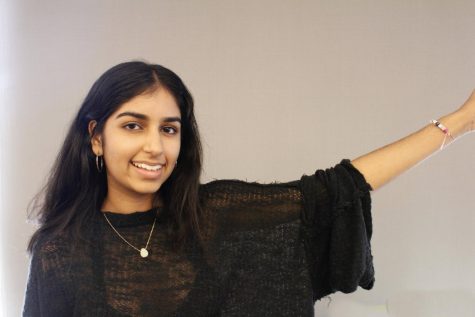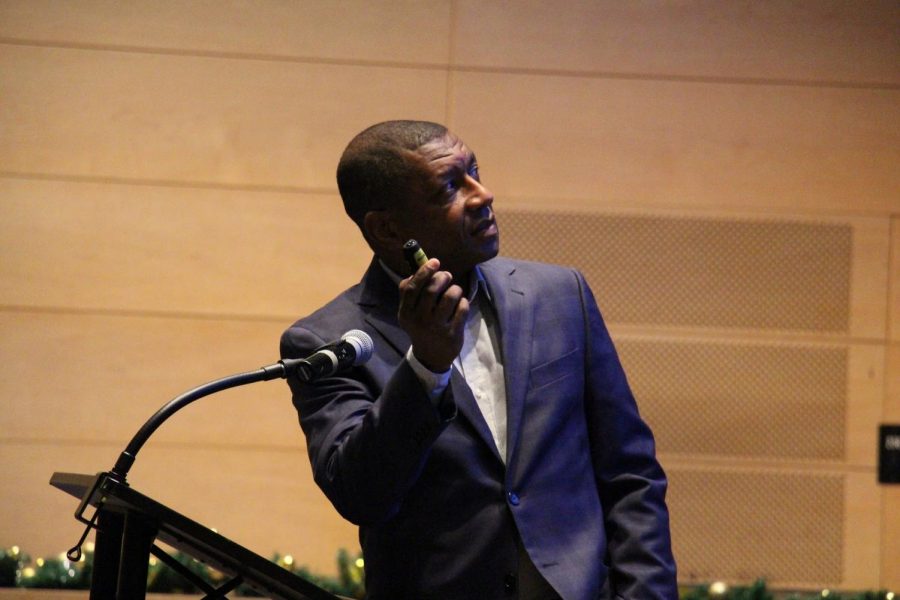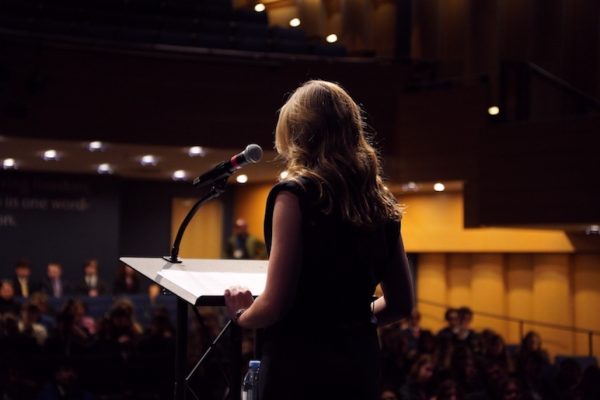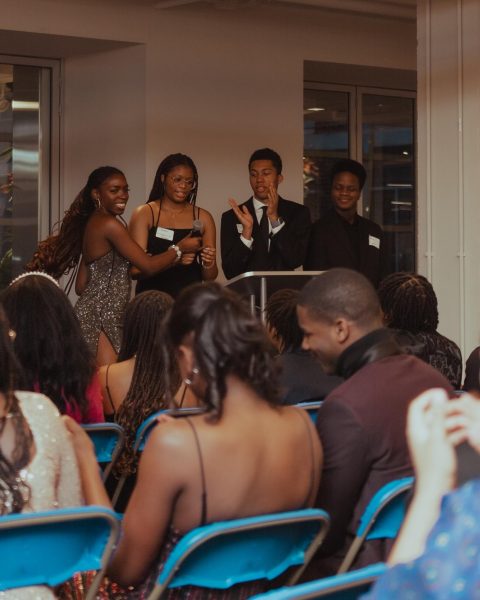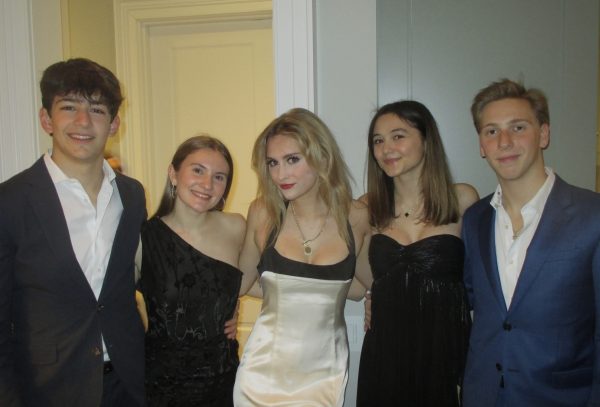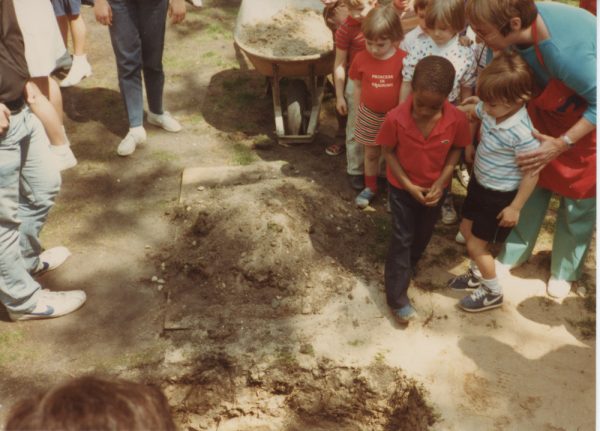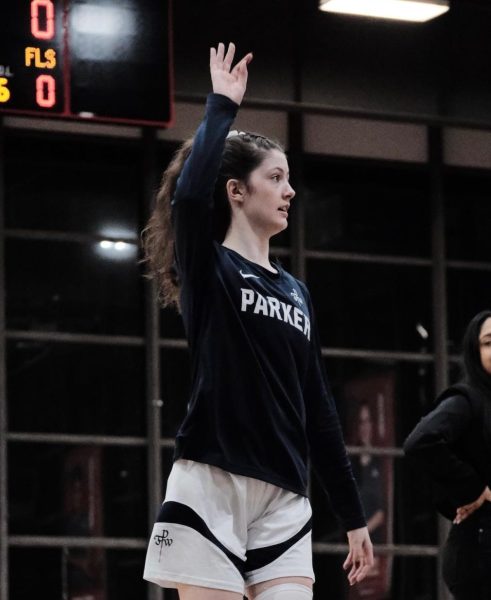Working Toward Racial Literacy
UPenn Professor Howard Stevenson Speaks as Robinson DEI Lecturer
Photo credit: Nick Saracino
Stevenson clicks through slides.
The Diane and David B. Heller Auditorium buzzed with chatter as audience members turned to one another and recounted one racial experience from their childhood. Attendees were asked to discuss how they handled an incident and how they wish they had.
This was just one of the exercises Howard Stevenson, Constance Clayton Professor of Urban Education, Professor of Africana Studies, Executive Director of the Racial Empowerment Collective at the University of Pennsylvania and co-director of Future Promise, asked the audience to participate in during his hour-long talk the night of December 9.
“Did you notice anything about yourself while you were talking or listening to your partner?” Stevenson asked. “What feeling did you have as you recounted these stories from your past?”
The crowd answered with descriptors like “rapid heartbeat,” “clammy hands,” “insecurity” and “angry.” Stevenson guided the crowd through a strategy he developed: “Calculate, Communicate, Breathe, and Exhale.”
“We need to talk about race in our society,” Stevenson said. “We don’t really want to have to do that because we’re so afraid. We’re afraid that people are going to think of us in a particular way. We’re afraid that if we say the wrong thing, we will never be able to live it down and our reputation will be soured. And yet, that makes us less competent to engage racial moments.”
Generally, Stevenson said, people are ill-equipped to deal with race because of a reluctance to speak about it. That is why particular strategies, including “Calculate, Communicate, Breathe, and Exhale” need to be developed and followed.
“We are withdrawn when something happens to us,” Stevenson said. “We don’t know how to prepare, we don’t know how to push.”
Stevenson followed the activity by asking if recounting a particular incident brought the audience members back to that moment. “In our world, we call that trauma,” Stevenson said. “Looking back can be traumatic, or it can be joyous, but forgetting it is not helpful. If something follows you twenty, thirty, or forty years in the future though, it becomes a matter of health.”
To Stevenson, his work is both a way to advance society in the way it addresses race, as well as a method of intervention in individual moments. “What if I told you that talking to your children about race would save them an hour of sleep over the next ten years? Would you consider doing it? Would you consider doing it if it also saved you an hour of sleep over the next ten years?”
The fact that measurable statistics like these do not exist can mean that conversations about race an racism take the backseat when raising a child. Stevenson urged parents and educators to think about the implications a lack of racial education could have for children.
“I want to know if we can be competent in navigating these racial encounters such that we walk away feeling healthy,” Stevenson said. “If you look at the racial threat research, the way in which people feel when they are threatened on a scale of eight, nine, or 10 [on a scale of 1-10], is that they lose peripheral vision and hearing and they distort what is right in front of them.”
Stevenson says that people must be able to see themselves struggle to handle a racial moment in the most effective way. The only way to accomplish such a difficult task, he claims, is to begin developing the skill in children. According to Stevenson, black kids are expelled from pre-schools, as opposed to middle or high schools, at the highest rate.
“Being threatened will distort how people see children as children,” Stevenson said. “It’s particularly important when we’re talking about children of color. Age really doesn’t matter as children look at the world around them, seeing black children associated with weapons and white boys associated with toys. That transition can happen in a matter of seconds.”
“Being threatened will distort how people see children as children.”
Children need to learn the skills to deal with racial encounters as young as possible. Another study Stevenson mentioned revealed that at 10 years old, black boys are seen as 14 or 15 years old by the general public, while white boys are seen as 10 years old.
“Imagine if your child was thought about going from home to school to after-school to the library and back home as 15 instead of 10,” Stevenson said. “How his or her world would be different. And how your worries about him would also be different.”
These statistics further Stevenson’s theory that racial literacy is a matter of health. For a child and their parent to remain emotionally healthy, they must obtain methods of coping with racial situations. For a child of color and their parent to remain physically healthy, the same is true.
“Managing acute or chronic stress where you’re thought of as less than a person can be detrimental to your health,” Stevenson said, “Being hurt because you’re thought of as less than a person can be detrimental to your health. Dealing with racial issues is not an issue of being a good or bad person, but it is a health issue.”
“Managing acute or chronic stress where you’re thought of as less than a person can be detrimental to your health.”
Stevenson studies racial literacy because it is essential to the individual health of millions. “I want police officers and educators and leaders and neighborhood strangers to look at my child and see their child,” Stevenson said. “Becuase I know you won’t shoot your child.”
Stevenson followed Charles Blow as the second D’Rita and Robbie Robinson Diversity, Equity and Inclusion Speaker, and was introduced to Parker by Derrick Gay, a consultant on issues of diversity, inclusion, and global citizenship who has worked with Parker for a number of years. Gay studied under Stevenson at Penn.
To introduce Stevenson, Gay told a story about a project he completed for Stevenson where he drew up numbers and charts to prove what he had been studying. For the first time, Stevenson asked him how the project made him feel, and Gay said he was stumped.
“I shied away from the emotional piece,” Gay said. “The effective piece. We talk about empathy and understanding, but without that effective piece, that emotional piece that Dr. Stevenson taught me, this work means nothing.”
